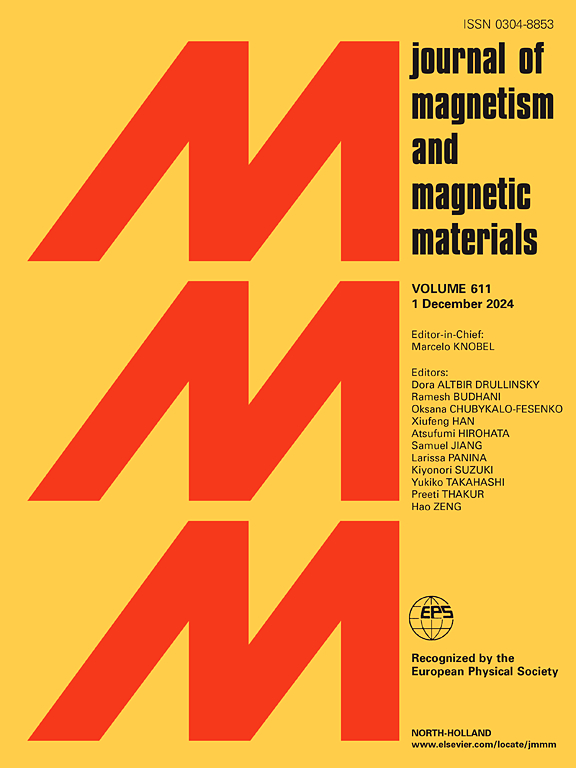Magnetic characteristics of threaded cores with round iron wires in AC magnetic fields
IF 2.5
3区 材料科学
Q3 MATERIALS SCIENCE, MULTIDISCIPLINARY
引用次数: 0
Abstract
This study explores the magnetic characteristics of threaded cores constructed with round cross-sectional iron wires, designed to mitigate eddy currents in magnetic devices. The threaded core comprised iron threads separated by an insulating material. Previous studies have demonstrated the remarkable efficacy of threaded cores in reducing eddy currents. These investigations employed iron threads with square cross-sectional structures. However, round cross-sectional wires are more prevalent in industrial applications owing to their productivity, cost-effectiveness, and superior mechanical properties. In this study, numerical and experimental analyses are conducted to examine the characteristics of round-wire threaded cores. In the numerical analysis, we compare the round-wire threaded core with other core types, namely the laminated core and square-wire threaded core, to assess their geometric attributes and magnetic performances. Additionally, further analysis is performed to examine the impact of round wire diameter on the magnetic performance of the threaded cores. The findings obtained from the numerical analysis are verified through experimental testing, which involves lab-made threaded cores using a commercially available round iron wire. This study reveals that round-wire threaded cores offer promising performance in reducing eddy currents, with smaller wire diameters exhibiting superior magnetic properties, particularly in high-frequency applications.
交流磁场中圆形铁线螺纹磁芯的磁特性
本研究探讨了用圆形横截面铁丝构建的螺纹芯的磁性特性,旨在减轻磁性设备中的涡流。螺纹芯由绝缘材料隔开的铁丝组成。以前的研究已经证明了螺纹芯在减少涡流方面的显着功效。这些研究采用了方形横截面结构的铁螺纹。然而,圆形截面线由于其生产率、成本效益和优越的机械性能而在工业应用中更为普遍。本文对圆丝螺纹芯的特性进行了数值和实验分析。在数值分析中,我们将圆丝螺纹铁芯与其他类型的铁芯(即层压铁芯和方丝螺纹铁芯)进行了比较,以评估其几何属性和磁性能。此外,还进行了进一步的分析,以检查圆线直径对螺纹芯的磁性能的影响。从数值分析中得到的结果通过实验测试得到验证,实验测试涉及使用市售的圆铁丝制成的实验室螺纹芯。这项研究表明,圆丝螺纹芯在减少涡流方面具有良好的性能,更小的丝径具有更好的磁性,特别是在高频应用中。
本文章由计算机程序翻译,如有差异,请以英文原文为准。
求助全文
约1分钟内获得全文
求助全文
来源期刊

Journal of Magnetism and Magnetic Materials
物理-材料科学:综合
CiteScore
5.30
自引率
11.10%
发文量
1149
审稿时长
59 days
期刊介绍:
The Journal of Magnetism and Magnetic Materials provides an important forum for the disclosure and discussion of original contributions covering the whole spectrum of topics, from basic magnetism to the technology and applications of magnetic materials. The journal encourages greater interaction between the basic and applied sub-disciplines of magnetism with comprehensive review articles, in addition to full-length contributions. In addition, other categories of contributions are welcome, including Critical Focused issues, Current Perspectives and Outreach to the General Public.
Main Categories:
Full-length articles:
Technically original research documents that report results of value to the communities that comprise the journal audience. The link between chemical, structural and microstructural properties on the one hand and magnetic properties on the other hand are encouraged.
In addition to general topics covering all areas of magnetism and magnetic materials, the full-length articles also include three sub-sections, focusing on Nanomagnetism, Spintronics and Applications.
The sub-section on Nanomagnetism contains articles on magnetic nanoparticles, nanowires, thin films, 2D materials and other nanoscale magnetic materials and their applications.
The sub-section on Spintronics contains articles on magnetoresistance, magnetoimpedance, magneto-optical phenomena, Micro-Electro-Mechanical Systems (MEMS), and other topics related to spin current control and magneto-transport phenomena. The sub-section on Applications display papers that focus on applications of magnetic materials. The applications need to show a connection to magnetism.
Review articles:
Review articles organize, clarify, and summarize existing major works in the areas covered by the Journal and provide comprehensive citations to the full spectrum of relevant literature.
 求助内容:
求助内容: 应助结果提醒方式:
应助结果提醒方式:


